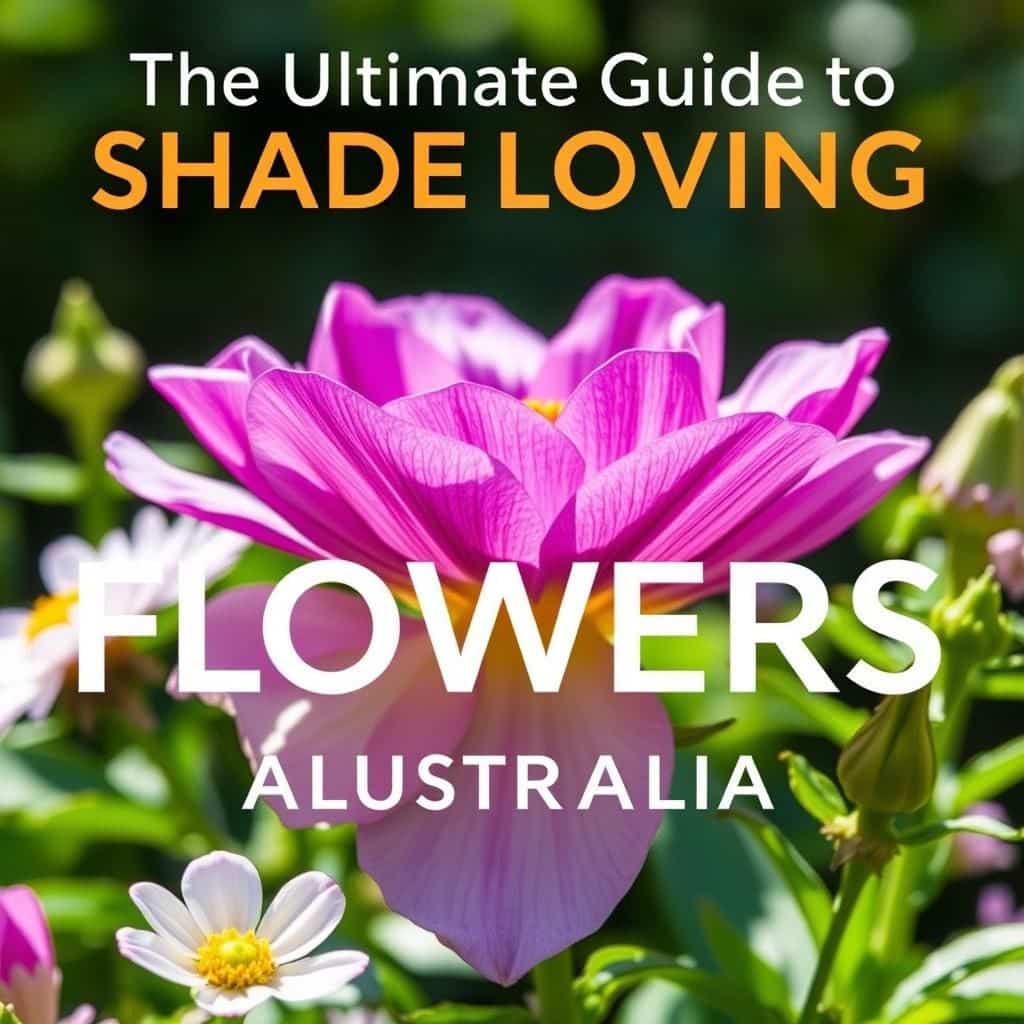The Ultimate Guide to Shade Loving Flowers Australia: Top Picks for Your Garden

When it comes to gardening in Australia, finding the right flowers that thrive in shaded areas can be a challenge. However, shade-loving flowers can transform dark corners of your garden into vibrant displays of color and texture. This ultimate guide will explore the best picks for shaded spots, ensuring your garden remains lively and inviting, even in low-light conditions. From indigenous Australian blooms to exotic varieties, we’ll highlight the most suitable options, offering tips on care and maintenance. Discover how to create stunning shaded gardens that flourish with beauty and resilience throughout the year.
Best Shade Loving Flowers for Australian Gardens
In Australia, selecting the right shade-loving flowers can create stunning gardens even in low-light conditions. Many regions experience varied climates, making it essential to choose plants that not only thrive in shade but also withstand specific environmental challenges. Some popular options include the Australian native bleeding heart (Dicentra spectabilis), which features delicate pink flowers, and the lush ferns that offer a rich green backdrop. Additionally, many perennials and annuals, such as impatiens and begonias, can add vibrant colors to shaded areas, making them perfect for creating eye-catching displays. By combining these flowers thoughtfully, gardeners can achieve a vibrant and diverse landscape.
Top Native Australian Shade Plants
Native Australian plants are ideally suited for local conditions, and many thrive in shaded environments. The Tasmanian native violet (Viola hederacea) and the Bluebell Creeper (Billardiera heterophylla) are two excellent choices, as they adapt beautifully to low-light conditions. These plants not only provide attractive blooms but also require minimal maintenance, making them a favorite for both seasoned and novice gardeners. Their resilience to Australia's varying climate adds to their appeal, ensuring that they remain robust and vibrant throughout the year.
Annuals that Flourish in the Shade
When it comes to annuals, certain varieties do exceptionally well in shaded areas of the garden. Impatiens, for instance, are well-known for their ability to bloom profusely in low-light situations, offering bright colors from spring to autumn. Another excellent choice is the begonia, which can add a touch of elegance with its unique leaf patterns and vibrant flowers. These annuals not only lighten up dark corners but also complement perennial shade lovers, providing continuous color and texture throughout the growing season.
Tips for Growing Shade-Loving Flowers
To successfully grow shade-loving flowers, it's essential to understand their specific light and soil requirements. Most shade plants prefer well-drained soil rich in organic matter, which supports healthy growth. It's also advantageous to provide adequate water, particularly during dry spells, as shaded areas can sometimes affect moisture retention. Regular mulching can help maintain soil temperature and moisture levels, ensuring that these flowers thrive in their environment. Pruning and deadheading spent blooms will encourage new growth, leading to a more lush and colorful display.
Combining Different Shade Plants
When combining various shade-loving plants, it's beneficial to consider their height, texture, and color to create a visually appealing arrangement. Taller plants like ferns can serve as a backdrop for shorter, colorful flowers such as violets or begonias. Additionally, incorporating plants with varying leaf structures can add depth and interest to shaded areas. Grouping plants in odd numbers and considering bloom times can result in a dynamic garden, as different species will flower at different times, providing continuous interest throughout the year.
Common Challenges of Growing Shade Plants
While shade-loving flowers are resilient, they can face specific challenges, such as disease and pest issues due to damp conditions often found in shady areas. Regular monitoring for issues like powdery mildew or aphid infestations is crucial for maintaining plant health. Additionally, competition from tree roots for nutrients and moisture can hinder growth, so proper site selection and soil amendment practices are vital. Understanding these challenges and taking proactive measures can greatly enhance the success of your shade garden.
| Flower Type | Growth Habit | Color | Height |
|---|---|---|---|
| Impatiens | Annual | Various | 30-45 cm |
| Begonia | Annual | Pink, Red, White | 20-40 cm |
| Tasmanian Violet | Perennial | Purple, Blue | 10-20 cm |
| Bluebell Creeper | Perennial | Yellow | 1-2 m |
| Ferns | Perennial | Green | 30-150 cm |
What flowers can tolerate full shade?

Full shade refers to areas that receive less than three hours of direct sunlight each day. Many gardeners believe that flower options are limited in such conditions, but several varieties actually thrive in low-light situations. Here are some flowers that can flourish in full shade:
1. Astilbe: These perennial plants are known for their feathery flower plumes and can add a touch of color to shady spots. They prefer moist, rich soil and come in various colors, including white, pink, and red.
See also:
2. Foxglove (Digitalis): This biennial or perennial plant showcases elegant, tubular flowers that bloom in a variety of colors like purple, pink, and white. They do well in nutrient-rich, moist soil and can tolerate full shade.
3. Bleeding Heart (Dicentra spectabilis): With their unique heart-shaped flowers, bleeding hearts are a popular choice for shaded gardens. They thrive in cool, moist environments and produce blooms in shades of pink and white.
4. Tiarella (Foamflower): Known for their delicate white flowers and attractive foliage, foamflowers prefer moist, shady areas. They can spread quickly and are great ground covers in woodland gardens.
5. Hosta Blooms: While many people grow hostas primarily for their lush foliage, they also produce spikes of lavender or white flowers. Hostas are hardy and can thrive in a variety of soil types, provided they receive adequate moisture.
Benefits of Planting Shade-Tolerant Flowers
Planting flowers that tolerate full shade comes with several advantages:
- Enhances the beauty of low-light areas in gardens with vibrant colors.
- Improves soil quality as various plants can help with moisture retention.
- Provides habitat for wildlife, including pollinators like bees and butterflies.
Care Tips for Full Shade Flowers
Taking care of shade-tolerant flowers requires specific maintenance tips to ensure their growth:
- Ensure the soil is well-draining to prevent root rot.
- Water regularly, especially during dry spells, to keep the soil moist.
- Apply a layer of mulch to maintain soil temperature and moisture levels.
Companion Plants for Shade Gardens
Companion planting can enhance the growth of shade flowers through beneficial interactions:
- Ferns can provide a lush green backdrop and thrive in similar conditions.
- Shade-tolerant grasses, like fescue, can offer texture to the garden.
- Other perennials like brunnera or pulmonaria can contribute to a diverse array of color and foliage.
Choosing the Right Location for Full Shade Flowers
Selecting an appropriate location is crucial for the success of your shade garden:
- Identify areas in your garden that receive limited sunlight throughout the day.
- Avoid spots directly under dense tree canopies, which can compete for water and nutrients.
- Consider planting near structures that block sunlight, like fences or walls.
Common Problems Faced by Shade Flowers
Even shade-tolerant flowers can encounter challenges in a garden:
- Pests such as slugs and snails can damage foliage, requiring vigilance and control methods.
- Excessive moisture can lead to root diseases; ensure proper spacing for air circulation.
- Low light may weaken some plants; rotating or varying the locations of your plants can help improve light exposure.
What Australian natives grow well in shade?


In Australia, various native plants thrive in shaded environments, which is particularly beneficial for garden enthusiasts seeking to cultivate greenery in less sunny areas. These plants not only provide aesthetic beauty but also support local ecosystems by attracting native wildlife. Below are some notable Australian natives known for their ability to flourish in shaded conditions.
1. Native Ferns
Native ferns are among the best options for shaded environments. They typically prefer moist, cool conditions and can tolerate the filtered light that comes through trees. Some popular species include:
- Fishbone Fern (Nephrolepis exaltata) - Known for its arching fronds and adaptability.
- Soft Tree Fern (Dicksonia antarctica) - A classic choice for shady gardens, with a tall trunk and lush foliage.
- Asplenium Nidus - Also known as the bird's nest fern, it has a rosette shape and prefers humid conditions.
2. Ground Covers
Many ground covers native to Australia thrive in shady areas, making them excellent choices for filling in spaces beneath trees or shrubs. Their dense growth habit helps suppress weeds as well. Popular options include:
- Creeping Boobialla (Myoporum parvifolium) - A low-growing plant that is hardy and drought-resistant.
- Australian Violet (Viola hederacea) - This small plant produces lovely purple flowers and tolerates shade well.
- Pigface (Carpobrotus rossii) - Known for its succulent leaves and vibrant flowers, it can thrive in poor soil.
3. Shrubs
There are several native shrubs that can adapt to shady conditions, providing both structure and beauty to the landscape. These shrubs may also offer habitat for birds and insects. Consider the following:
- Correa - A hardy shrub with lovely bell-shaped flowers, ideal for shaded areas.
- Native Fuchsia (Correa alba) - Known for its attractive flowers and dense foliage.
- Western Australian Brushwood (Melaleuca uncinata) - A versatile plant that can grow in various light conditions.
4. Trees for Shade
Certain tree species also perform well in shaded conditions, providing significant canopy cover. These trees can support a variety of understory plants while creating cool shaded spots. Some great choices include:
- Paperbark Tree (Melaleuca quinquenervia) - A hardy tree with distinctive bark that thrives in wet conditions.
- Southern Blue Gum (Eucalyptus globulus) - A tall tree that offers excellent shade and habitat for wildlife.
- Blackwood Acacia (Acacia melanoxylon) - Known for its attractive foliage and fragrant flowers.
5. Succulents and Cacti
While many succulents prefer sunlight, some Australian natives can tolerate shade and make interesting additions to mixed plantings. They are particularly appealing due to their low-maintenance needs. Useful plants in this category can include:
- Ruby Saltbush (Enchylaena tomentosum) - A resilient plant with decorative berries that can grow in semi-shade.
- Sturt's Desert Pea (Swainsona formosa) - Known for its striking flowers, it can occasionally tolerate partial shade.
- Eastern Starbush (Calytrix tetragona) - Features bright flowers and can thrive in dappled light conditions.
Questions from Our Readers
What are the best shade-loving flowers for gardens in Australia?
Some of the best shade-loving flowers for gardens in Australia include Hostas, Fuchsias, and Begonias. These plants thrive in low light conditions and can bring lovely colors and textures to shaded areas, making them ideal for creating vibrant garden spots under trees or along shaded pathways.
How do I care for shade-loving flowers in Australia?
Caring for shade-loving flowers involves ensuring they receive adequate moisture without becoming waterlogged. Regularly check the soil moisture, use mulch to retain moisture, and apply a balanced fertilizer during the growing season to support their growth in shaded environments.
Can shade-loving flowers survive in full shade?
Most shade-loving flowers can thrive in partial shade, but some can adapt to full shade situations. It's important to choose specific varieties such as ferns and certain types of Impatiens, as they are more tolerant to low light and can still flourish without direct sunlight.
What are some common challenges when growing shade-loving flowers?
Common challenges include dealing with excessive moisture, limited air circulation, and pests that may thrive in damp, shaded conditions. It's essential to monitor for signs of fungal diseases and pests, ensuring proper spacing and drainage practices to promote healthy plants in shaded areas.
See also:

If you want to read more articles like The Ultimate Guide to Shade Loving Flowers Australia: Top Picks for Your Garden, we recommend you check out our Landscaping category.
Leave a Reply
Related Articles